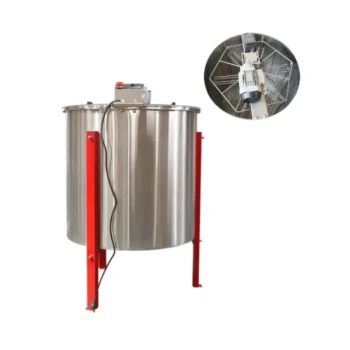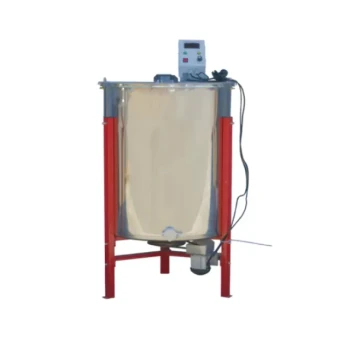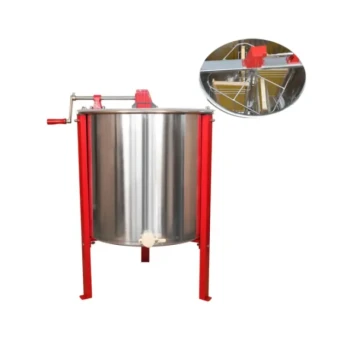Choosing between an electric and manual honey extractor is a critical decision that hinges on the scale of your beekeeping operation, your budget, and the value you place on your time and physical effort. For small-scale hobbyists, a manual extractor is often a cost-effective starting point, while electric models become essential for efficiency as your apiary grows.
The core decision is a trade-off between upfront investment and long-term efficiency. Manual extractors offer a low-cost entry for beekeepers with very few hives, while electric extractors are a necessary investment for anyone who values speed, scalability, and reduced physical labor.
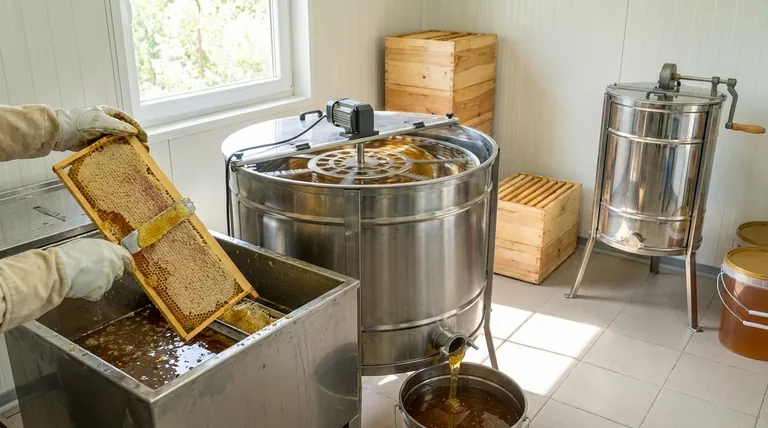
The Fundamental Difference: Motor vs. Muscle
Before weighing the factors, it's important to understand the simple mechanical distinction between the two types of equipment. This core difference drives all other considerations.
How a Manual Extractor Works
A manual extractor relies entirely on your physical power. You use a hand crank to spin a central basket that holds the honey frames. The speed and duration of the spin are entirely under your control.
How an Electric Extractor Works
An electric extractor uses a motor to do the spinning for you. This provides a consistent speed and frees you to perform other tasks, such as uncapping the next batch of frames, while the machine runs.
Key Decision Factors for Your Apiary
Your choice will ultimately be determined by the unique characteristics of your beekeeping practice. Answering these questions honestly will lead you to the right tool.
Scale of Your Operation
This is the most important factor. A common rule of thumb is the "hive count rule." If you manage between one and five hives, the workload is generally manageable with a manual extractor.
For apiaries with more than five hives, and especially for those with ten or more, an electric model quickly shifts from a luxury to a necessity.
Time and Physical Labor
Extracting honey is a physically demanding process. Turning a hand crank for an extended period is strenuous, especially with multiple supers to process.
An electric extractor dramatically reduces extraction time and eliminates the physical strain, preventing beekeeper burnout and making harvest day significantly more enjoyable.
Initial Investment and Budget
There is a clear cost difference. Manual extractors are significantly less expensive, making them an accessible entry point for new beekeepers who are managing initial startup costs.
Electric extractors represent a larger upfront investment but pay for themselves over time through saved labor and increased efficiency.
Your Beekeeping Philosophy
Some beekeepers prefer a more tactile, hands-on approach and enjoy the simple mechanics of a manual extractor. It offers a quiet, off-grid method that aligns with a traditionalist philosophy.
Others prioritize modern efficiency and view the extractor as a tool to get a job done as quickly as possible.
A Critical Detail: Radial vs. Tangential Design
Beyond the power source, the internal design of the extractor basket is crucial. This choice exists for both manual and electric models and directly impacts your workflow.
Tangential Extractors
A tangential extractor holds the frames flat against the side of the drum. This design only extracts honey from one side of the frame at a time.
You must stop the process, flip each frame by hand, and then spin again. This is common in smaller, less expensive models.
Radial Extractors
A radial extractor positions frames like the spokes of a wheel. Centrifugal force extracts honey from both sides of the frame simultaneously.
This design is far more efficient as it eliminates the need to flip frames, saving a significant amount of time and handling. Most serious beekeepers prefer radial designs.
Understanding the Trade-offs
No tool is perfect. Being aware of the inherent downsides of each option is key to making an informed decision without regret.
The Downsides of a Manual Extractor
The primary drawback is the intense physical labor required. It can be slow and exhausting, especially as your hive count grows. What seems manageable with two hives can become an overwhelming chore with six.
The Downsides of an Electric Extractor
The most obvious drawback is the higher initial cost. It also requires a reliable power source, which may be a consideration for apiaries in remote locations. Finally, an unattended electric model could potentially spin too fast and damage delicate new comb if not set properly.
Making the Right Choice for Your Goal
Select your equipment based on a realistic assessment of your current needs and future ambitions.
- If your primary focus is a small hobby (1-5 hives): A manual tangential extractor is the most cost-effective and practical choice to start.
- If your primary focus is growth and efficiency (5+ hives): An electric radial extractor is the wisest long-term investment to save you immense time and labor.
- If your primary focus is budget above all else: A manual extractor is your starting point, but be prepared for the significant physical commitment it requires.
Ultimately, the right extractor is a tool that supports your beekeeping goals without becoming a bottleneck to your success and enjoyment.
Summary Table:
| Factor | Manual Extractor | Electric Extractor |
|---|---|---|
| Best For | Small-scale hobbyists (1-5 hives) | Commercial apiaries & growing operations (5+ hives) |
| Initial Cost | Lower upfront investment | Higher initial cost, long-term efficiency gain |
| Labor & Time | High physical effort, slower process | Minimal labor, faster, consistent extraction |
| Key Consideration | Budget-friendly entry point | Essential for scalability and reducing physical strain |
Ready to Scale Your Honey Harvesting Efficiency?
As a leading wholesale supplier to commercial apiaries and beekeeping equipment distributors, HONESTBEE provides the durable, high-capacity extraction equipment you need to maximize productivity. Whether you're upgrading to an electric radial extractor for a large-scale operation or need reliable manual models for smaller setups, our solutions are built for professional beekeeping success.
Contact HONESTBEE today to discuss your specific needs and discover how our wholesale-focused supply chain can benefit your business.
Visual Guide
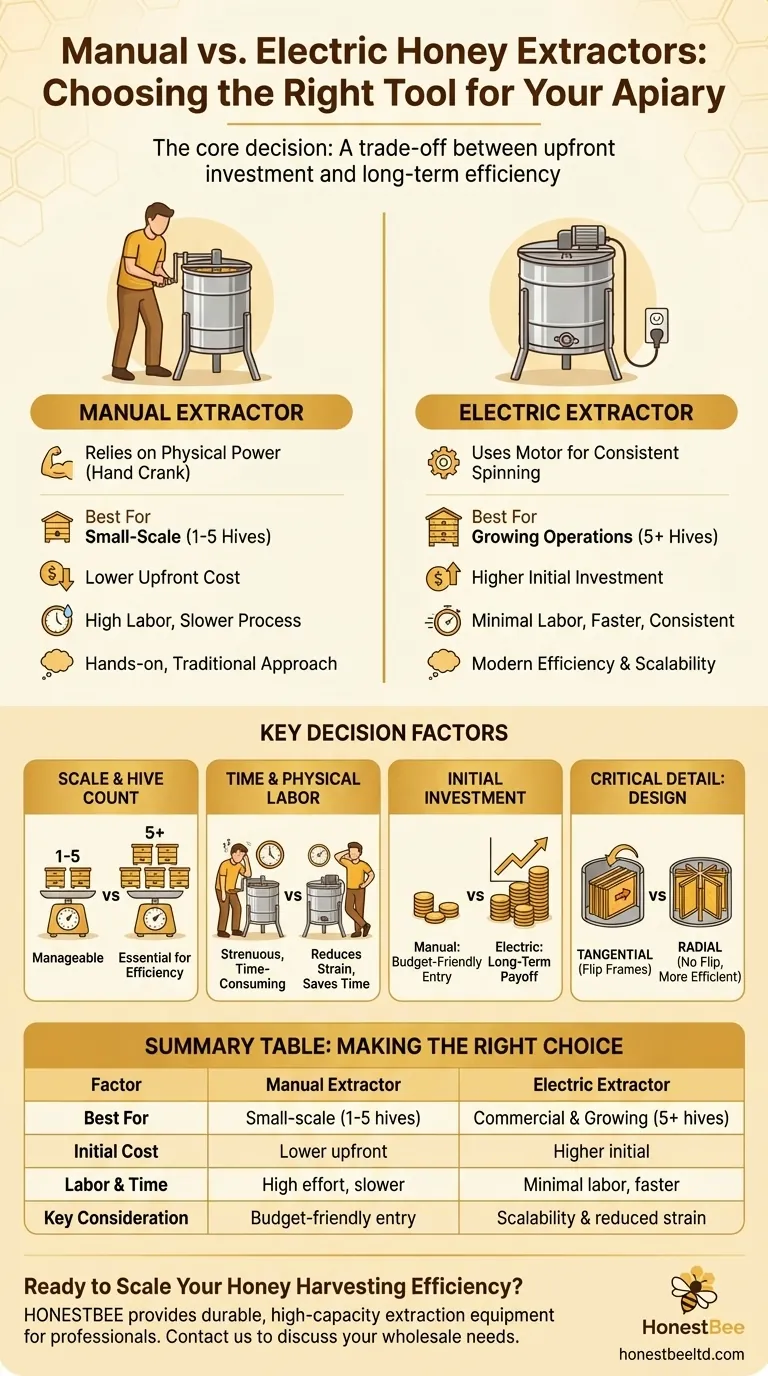
Related Products
- HONESTBEE 72 Frame Industrial Electric Honey Extractor for Beekeeping
- HONESTBEE 6 Frame Self Reversing Electric Honey Extractor for Beekeeping
- Professional 4 Frame Self Reversing Electric Honey Extractor for Beekeeping
- 8-Frame Electric Self-Reversing Honey Extractor Spinner for Commercial Honey Extraction Equipment
- HONESTBEE 3-Frame Manual Acrylic Honey Extractor
People Also Ask
- What are the two common types of honey extractors? Choose the Right Extractor for Your Apiary
- What should a beekeeper do after extracting honey from supers? A Guide to Harvest Management
- Why do beekeepers have to lift a lot of weight at the end of a growing season? The Reward of a Heavy Harvest
- Why is preserving honeycomb integrity important, and how do automated extractors help? Boost Hive Health & Honey Yields
- How is honey harvested from Langstroth hives? A Guide to Efficient, Comb-Preserving Extraction

